<< Previous | Displaying results 2626-2650 of 6771 for "" | Next >>
A US PT (Patrol Torpedo) boat off the coast of New Guinea, during an American counteroffensive against Japanese advances in the Solomon Islands in the eastern Pacific Ocean, 1943.
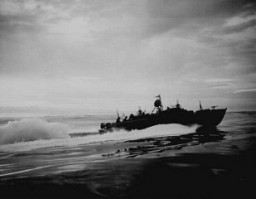
US Marines head for the front lines in the jungles of Bougainville, one of the Solomon Islands in the Pacific Ocean. 1943.
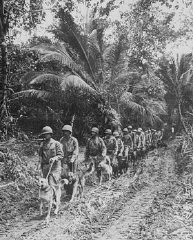
An amphibious troop carrier loaded with US Marines heads for the beaches of Tinian, an island in the Pacific Ocean. July 1944.
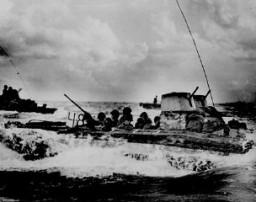
US Marines during the final stage of the fight for Peleliu Island in the Pacific theater of war. September 14, 1944.
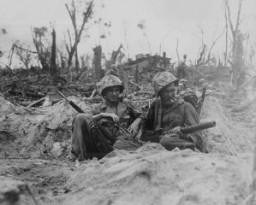
Supply ships reinforce US forces on the Philippine island of Leyte during the US invasion of the Philippines. 1944.
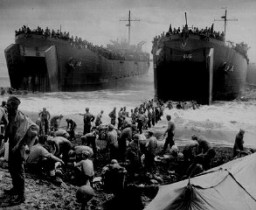
US sailors struggle to contain damage from Kamikaze attacks during the US invasion of Okinawa, the largest of the Ryukyu Islands (the islands closest to the Japanese home islands). May 11, 1945.
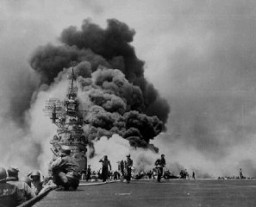
Nazi foreign minister Joachim von Ribbentrop (left), Soviet leader Joseph Stalin (center), and Soviet foreign minister Viacheslav Molotov (right) at the signing of the nonaggression pact between Germany and the Soviet Union. Moscow, Soviet Union, August 1939.
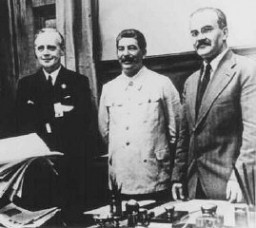
Soviet foreign minister Viacheslav Molotov signs the German-Soviet pact as Soviet leader Joseph Stalin (white uniform) and German foreign minister Joachim von Ribbentrop (behind Molotov) look on. Moscow, Soviet Union, August 23, 1939.
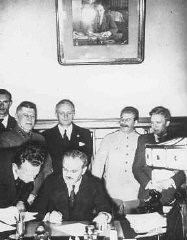
Two German sentries stand guard at Augustow on the demarcation line between Soviet- and German-occupied Poland. September 1939.
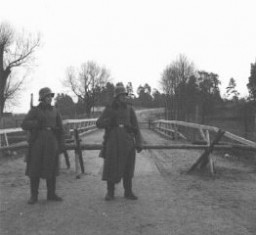
A post marked with Soviet symbols along the demarcation line between German- and Soviet-occupied Poland.
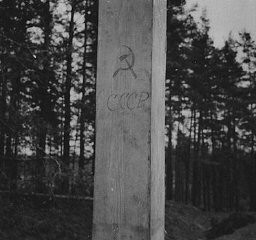
General Dwight D. Eisenhower visits with paratroopers of the 101st Airborne Division just hours before their jump into German-occupied France (D-Day). June 5, 1944.
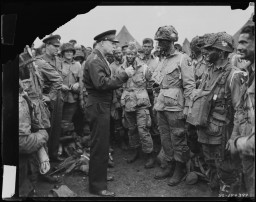
Assault troops in a landing craft approach Omaha Beach on D-Day. Normandy, France, June 6, 1944.
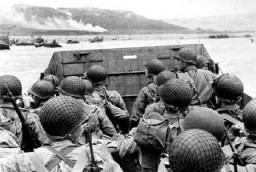
US troops wade through the surf on their arrival at the Normandy beaches on D-Day. Normandy, France, June 6, 1944.
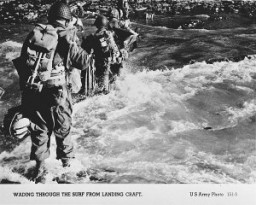
US troops pull the survivors of a sunken craft onto the shores of the Normandy beaches on D-Day. Normandy, France, June 6, 1944.
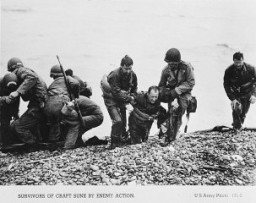
The Normandy beach as it appeared after D-Day. Landing craft on the beach unload troops and supplies transferred from transports offshore. Barrage balloons hover overhead to deter German aircraft. Normandy, France, undated (after June 6, 1944).
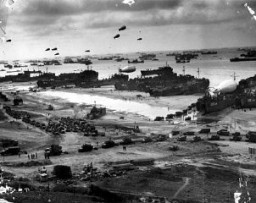
Teenager Simon Jeruchim learned of the Allied invasion of German-occupied France (D-Day) on a shortwave radio. He painted a watercolor depiction of the bombing and burning of a town situated on a river. He titled the piece "Memory of June 6, 1944." Simon Jeruchim was born in Paris in 1929 to Samuel and Sonia (née Szpiro), Jewish émigrés from Poland. In July 1942, Simon’s parents were able to find hiding places for him and his siblings, but they were arrested and deported to Auschwitz before they…
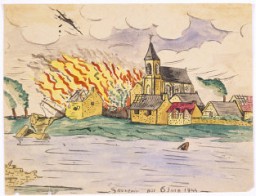
Graduates of the Piotrkow Trybunalski Hebrew Gymnasium (Jewish high school). Piotrkow Trybunalski, Poland, 1929.
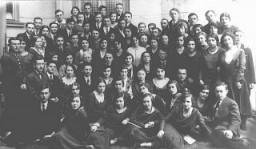
A first-grade class at a Jewish school. Cologne, Germany, 1929-1930.
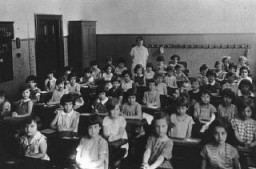
Three generations of a Jewish family pose for a group photograph. Vilna, 1938-39. The photo was taken during daughter Mina's visit from Montreal. Among those pictured are Mina (Katz) Herman and her daughter, Audrey (front row, second from the right), Itzik Katz, Mina's brother (standing at the far left) and Malka Katz, Mina's mother (front row, center).
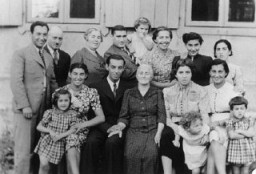
Jewish children gathered for a sporting event in a summer camp organized by the Reich Union of Jewish Frontline Soldiers. Germany, between 1934 and 1936.

Class photo of students and a teacher at a Jewish school in prewar Karlsruhe. Germany, July 1937.
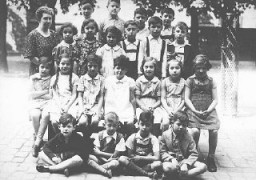
An American soldier looks at the corpses of Polish, Russian, and Hungarian Jews found in the woods near Neunburg vorm Wald. The victims were prisoners from Flossenbürg who were shot near Neunburg while on a death march. Germany, April 29, 1945.
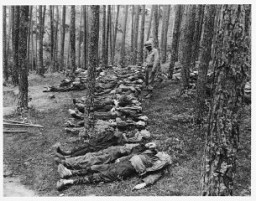
The bodies of Jewish women exhumed from a mass grave near Volary. The victims died at the end of a death march from Helmbrechts, a subcamp of Flossenbürg. Germans were forced to exhume them in order to give the victims proper burial. Volary, Czechoslovakia, May 11, 1945.
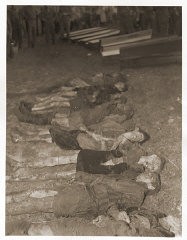
Under the supervision of American medics, German civilians file past the bodies of Jewish women exhumed from a mass grave in Volary. The victims died at the end of a death march from Helmbrechts, a subcamp of Flossenbürg. Germans were forced to exhume them in order to give the victims proper burial. Volary, Czechoslovakia, May 11, 1945.

German civilians from Volary attend burial services for the Jewish women exhumed from a mass grave in the town. The victims died at the end of a death march from Helmbrechts, a subcamp of Flossenbürg. Germans were forced to exhume them in order to give the victims proper burial. Volary, Czechoslovakia, May 11, 1945.
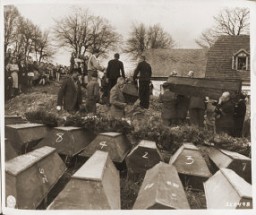
We would like to thank Crown Family Philanthropies, Abe and Ida Cooper Foundation, the Claims Conference, EVZ, and BMF for supporting the ongoing work to create content and resources for the Holocaust Encyclopedia. View the list of donor acknowledgement.